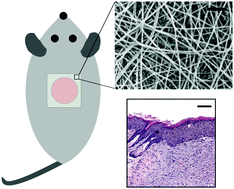Chitosan–poly(caprolactone) nanofibers for skin repair
Abstract
Dermal wounds, both acute and chronic, represent a significant clinical challenge, and therefore the development of novel biomaterial-based skin substitutes to promote skin repair is essential. Nanofibers have gained attention as materials to promote skin regeneration due to the similarities in morphology and dimensionality between nanofibers and native extracellular matrix proteins, which are critical in guiding cutaneous wound healing. Electrospun chitosan–poly(caprolactone) (CPCL) nanofiber scaffolds, which combine the important intrinsic biological properties of chitosan and the mechanical integrity and stability of PCL, were evaluated as skin tissue engineering scaffolds using a mouse cutaneous excisional skin defect model. Gross assessment of the wound size and measurement of defect recovery over time as well as histological evaluation of wound healing showed that CPCL nanofiber scaffolds increased the wound healing rate and promoted more complete wound closure when compared with Tegaderm, a commercially available occlusive dressing. CPCL nanofiber scaffolds represent a biomimetic approach to skin repair by serving as an immediately available provisional matrix to promote wound closure. These nanofiber scaffolds may have significant potential as a skin substitute or as the basis for more complex skin tissue engineering constructs involving integration with biologics.



 Please wait while we load your content...
Please wait while we load your content...